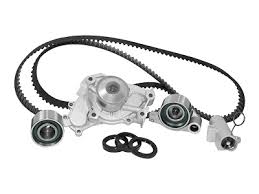Few car problems are as devastating—and expensive—as engine failure. One of the most overlooked causes is a worn or broken timing belt. When this component fails, it can cause severe damage to pistons, valves, and the engine block. That’s why timely replacement of timing belt kits is not optional—it’s essential.
What Are Timing Belt Kits?
A timing belt kit is more than just the belt. It includes the belt itself, tensioners, and idler pulleys that work together to keep your engine’s camshaft and crankshaft synchronized. Without them, your engine cannot run efficiently.
Choosing a complete timing belt kit ensures that all related components are replaced at the same time, preventing uneven wear and reducing the risk of sudden failure.
Warning Signs of a Failing Timing Belt
Unlike other car parts, timing belts don’t always show obvious signs before failing. However, there are some indicators to watch for:
- Ticking or clicking noises from the engine.
- Engine misfires caused by incorrect timing.
- Visible cracks or fraying on the belt.
- Difficulty starting the engine or sudden stalling.
- Oil leaks near the timing belt cover.
If you notice any of these, it’s time to replace your timing belt kit immediately.
Why You Should Replace the Entire Kit
Some drivers consider changing only the belt, but that’s a risky move. Tensioners and pulleys wear at the same rate and can cause a new belt to fail prematurely if not replaced.
A complete timing belt kit provides:
- Perfect synchronization of engine components.
- Improved reliability by renewing all related parts.
- Lower labor costs, since everything is replaced at once.
- Long-term performance, avoiding repeat repairs.
Dangers of Ignoring a Bad Timing Belt
Neglecting a timing belt replacement is one of the most expensive mistakes car owners make:
- Engine failure due to bent valves and piston damage.
- Sudden breakdowns that leave you stranded.
- High repair bills, often costing more than the car’s value.
Replacing your timing belt kits on schedule protects your wallet and keeps your car running smoothly.
Benefits of Timely Replacement
When you invest in a quality kit and replace it at the recommended interval, you gain:
- Peace of mind knowing your engine is protected.
- Better fuel efficiency thanks to precise timing.
- Extended engine life by reducing internal stress.
- Smoother performance with less risk of misfires or stalls.
When Should You Replace Timing Belt Kits?
Most manufacturers recommend replacing timing belts between 60,000 and 100,000 miles, but this varies by vehicle. Always follow your car’s service manual. If you drive in extreme conditions (hot climates, heavy towing, or frequent stop-and-go traffic), earlier replacement may be necessary.
Final Thoughts
A timing belt failure can destroy your engine and cost thousands in repairs. That’s why replacing timing belt kits on time is one of the smartest investments in car maintenance. With a complete kit, you ensure all components work together, giving you long-lasting reliability and peace of mind.


